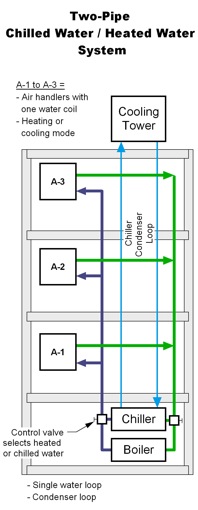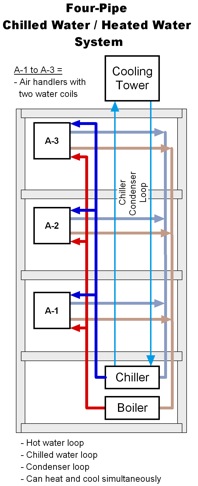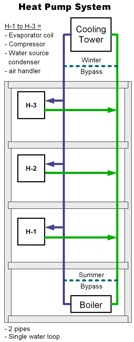Air conditioning systems for buildings may rely on either a liquid, such as water, or air as a distribution medium. Conditioned air is typically distributed by duct and chilled water is distributed by pipe. Chilled water distribution systems are most commonly found for air conditioning large buildings. The reason for this is it is more efficient and economical to transfer (or remove) heat by water rather than by air. This is due to the higher heat capacity water has and the fact pipes that carry water are smaller and take up far less space. A third advantage of chilled water is flexibility for zone control.
The chilled water will eventually cool air locally by convection, through air handling units or fan coil units. Air handling units are typically larger than fan coil units and have more sophisticated zone controls. Air handling units are often found in large office buildings, hospitals, etc. Fan coil units are typically smaller and serve smaller spaces. These units are typically controlled by simple thermostats and are often found in residential buildings, hotels, etc.
Chilled water is typically distributed by pipe from a system that features cooling towers and chillers. The operation of chillers and cooling towers is a subject for future discussion. A system that is similar to a chilled water system is a water source heat pump system. Water source heat pump systems would also typically have a cooling tower, but no chiller.
Chilled water distribution systems can use the same pipe system as the hot water heating systems. A water source heat pump system would also provide heat, utilizing the same water loop.
Two-pipe vs. four-pipe systems
When utilizing chilled water and air handlers or fan coils to cool (and heat with hot water) a building, there is a distinction between two-pipe and four-pipe systems. In a two-pipe system there is only one water loop and thus two pipes at each air handler or fan coil (supply pipe and return pipe). So, the building can either be in cooling mode or heating mode. In these situations, there is often a switch over date where the chiller is shut down for the season and the boiler is started, or vice-versa. After the switch over date, if there is a heat wave, it will not likely be possible to cool the building because the chiller has been shut down and the water loop has been directed through the boiler. Control valves are used to switch the system from heating to cooling and back.
See Figure 1.
In a four-pipe system, there are two separate water loops used for heated water and chilled water. This allows both systems to operate simultaneously for those times when some parts of the building need to be heated and other parts need to be cooled. Additionally, there is no seasonal switch necessary. It is easier to switch between heating and cooling when the outdoor temperature is unstable. The four pipe systems are obviously more expensive because of the additional water loop, controls and more expensive coils in the air handlers. See Figure 2.


Heat pump systems
Heat pumps may be either liquid or air source. Liquid or water source heat pump systems typically consist of various smaller units above the ceiling tile or in closets on each floor of a high-rise building. In a liquid source heat pump system there is a single water loop.
When air conditioning, the water loop is gathering heat from the refrigerant at the heat pumps. This takes place in the heat pump’s condensing coil. The water loop must then reject the heat; this is typically accomplished through a cooling tower outside the building. See Figure 3.
When heating, the water loop is providing heat to the refrigerant at the heat pumps. The water loop must then gather more heat; this is typically accomplished through a boiler inside the building.
In some heat pump systems, heat is moved from one side of the building to the other: the heat that comes into the water loop from spaces on the south side is used to heat the spaces on the north side.

By Richard Weldon – P.Eng, LEED AP